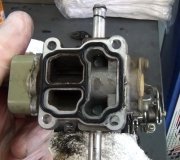Hi,
I understand. I was thinking something could be causing it to stick open. As far as further diagnosis, the next thing would be to check engine compression. If the cylinder is low, that also can cause a misfire.
I'm sorry. I feel like I just keep adding more to do, but I'm trying to touch on all the things that can cause the misfire. If it isn't ignition and seems limited to one specific cylinder, then it leads me to believe it is fuel related or a compression issue.
If you can, here is a link that shows how to test compression in general:
https://www.2carpros.com/articles/how-to-test-engine-compression
Here are the manufacturer's directions which include the specs:
__________________________
2010 GMC Truck Acadia AWD V6-3.6L
Engine Compression
Vehicle Powertrain Management Tune-up and Engine Performance Checks Compression Check Testing and Inspection Component Tests and General Diagnostics Engine Compression
ENGINE COMPRESSION
Engine Compression Test
Tools Required
J 39313 Spark Plug Port Adapter
A compression pressure test of the engine cylinders determines the condition of the rings, the valves and the head gasket.
1. Run the engine until it reaches normal operating temperature. The battery must be at or near full charge.
2. Turn the engine OFF.
Important: Remove the powertrain control module (PCM) and the ignition fuse from the instrument panel (I/P) fuse block.
3. Disable the ignition.
4. Disable the fuel systems.
5. Remove the spark plugs from all cylinders.
6. Remove the air duct from the throttle body.
7. Block the throttle plate in open position.
8. Measure the engine compression, using the following procedure:
1. Thread the J 39313 into the spark plug hole.
2. Thread the compression gage into the J 39313.
3. Have an assistant crank the engine through, at least 4 compression strokes, in the testing cylinder.
4. Check and record the readings on the gage at each stroke.
5. Remove the compression gage from the J 39313.
6. Remove the J 39313 from the spark plug hole.
7. Repeat the compression test for each cylinder.
9. Record the compression readings from all of the cylinders.
* The lowest reading should not be less than 70 percent of the highest reading.
* No cylinder reading should be less than 965 kPa (140 psi).
10. The following are examples of measurement problems:
* When the compression measurement is normal, the compression builds up quickly and evenly to specified compression on each cylinder.
* When low compression is caused by the piston rings, compression is low on the first stroke and tends to build up on the following strokes, but does not reach normal. Compression improves considerably with the addition of oil. Use approximately 3 squirts of oil from a plunger-type oiler.
* When low compression is caused by the valves, the measurement is low on the first stroke and does not build up even with the addition of oil.
* Leaking head gaskets will provide the same results as worn valves but engine coolant may be identified in the crankcase. In addition, a leaking head gasket will give low readings on paired cylinders.
11. Remove the block from the throttle plate.
12. Install the air duct to the throttle body.
13. Install the spark plugs.
14. Install the powertrain control module (PCM).
15. Install the ignition fuses to the I/P fuse block.
___________________________________________
Let me know if you are comfortable doing this.
Take care,
Joe
Saturday, December 19th, 2020 AT 2:40 PM














